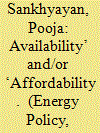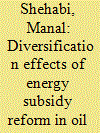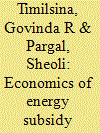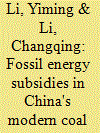|
|
|
Sort Order |
|
|
|
Items / Page
|
|
|
|
|
|
|
| Srl | Item |
| 1 |
ID:
113414


|
|
|
|
|
| Publication |
2012.
|
| Summary/Abstract |
This paper presents an analytical hierarchy process (AHP) decision model for sectoral allocation of energy subsidy based on several criteria. With determination of priorities for these criteria through questionnaire and AHP method, the overall rank of these criteria that have the most influence on distribution of energy subsidy among socio-economic sub-sectors, are as the following: inflation, economic growth, labor intensity, distribution of energy subsidy among socio-economic levels, energy intensity and social cost of air pollution. According to the model, the first priority for allocation of energy subsidy is commercial sector and the last priority is related to transportation sector. Investigating the impact of changing priority of the criteria on overall results indicates that the socio-economic sub sectors' ranking in receiving subsidy have little sensitivity for changing priority of the subsidy criteria.
|
|
|
|
|
|
|
|
|
|
|
|
|
|
|
|
| 2 |
ID:
166714


|
|
|
|
|
| Summary/Abstract |
While access to cleaner fuel is a sustainable development goal, the transition from traditional to modern fuel is yet to be achieved in India. This paper estimates fuel costs associated with such transitions and analyses the determinants of access to electricity for lighting and Liquified Petroleum Gas (LPG) for cooking. State-level regression models based on data from 61st (2004–05), 68th (2011–12) and 71st (2014) rounds of National Sample Survey are used. While energy expenditures are found to be comparable for kerosene and electricity for lighting, it increases 3.6–8.8-fold for transition to LPG from traditional fuel. Availability is important for greater uptake of electricity i.e. higher rate of electrification helps, but the same is not true for LPG. While untargeted tariff-subsidy leads to significant budgetary pressure, it doesn't affect the access. States with higher income and literacy rate/women empowerment have greater access to LPG and electricity. This shows while Indian energy policies always focused on removal of supply-side barriers through infrastructure creation, removal of first cost barrier and subsidizing tariff, a more meaningful way to ensure access is perhaps to integrate energy policies within the broader arena of comprehensive development policies to ensure improvement in socio-economic indicators.
|
|
|
|
|
|
|
|
|
|
|
|
|
|
|
|
| 3 |
ID:
171376


|
|
|
|
|
| Summary/Abstract |
Policy makers across Europe have implemented renewable support policies with several policy objectives in mind. Among these are achieving ambitious renewable energy targets at the lowest cost, reducing CO2-emissions and promoting technology improvement through learning-by-doing. Using a detailed country-level model of generation markets, we address the question of how policies that subsidize renewable energy (feed-in premia and renewable portfolio standards (RPSs)) versus capacity (investment subsidies) impact the mix of renewable investments, electricity costs, renewable share, the amount of subsidies, and consumer prices in the EU electric power market in 2030 and how they interact with other policies such as the EU ETS. Our analysis shows that subsidies of energy output are cost-effective for achieving renewable energy targets in the short run, whereas policies tied to capacity installation yield more investment and might be more effective in reducing technology costs in the longer term. The difference in costs between these two policy options diminish with higher CO2-prices. Although the differences are significant, they are smaller than cost impacts of other renewable policy design features, namely the effect of not allowing EU members to meet their individual targets by trading renewable credits with other member states.
|
|
|
|
|
|
|
|
|
|
|
|
|
|
|
|
| 4 |
ID:
171484


|
|
|
|
|
| Summary/Abstract |
For oil exporters, energy subsidy reform and economic diversification are critical policy responses to recent fundamental changes in the global oil market and oil price declines, yet the relationship between them is little understood. This article investigates linkages between energy subsidy reform and accelerating economic diversification away from hydrocarbons in a low oil price environment, using illustrations from Kuwait. It employs an economy-wide, general equilibrium model with oligopolistic industrial structure, the first of its kind for an economy in the Middle East and North Africa, that embodies unique elements of the country's economic structure—oil dependence; public sector dominance; subsidies; sovereign wealth funds; industrial collusive pricing behaviour; and guest workers. The article argues that, contrary to common popular discourse, Kuwait's economy has a diversified economic base, but this base fails to diversify export or government revenue needed for economic sustainability. Results show that weak economic diversification in oil exporters with a similar economic structure is not primarily due to “Dutch disease,” as dominant in the literature, but to economic constraints and distortions that impair structural change and exacerbate overdependence on hydrocarbons. Labour and competition reforms relax some constraints, achieving large efficiency gains that extend economy-wide and can expand non-energy tradable sectors. The analysis has important policy implications. First, the potential role of pricing regulation in small economies in moderating economic impacts of negative oil shocks. Second, in oil economies characterized by pervasive oligopolies, microeconomic reform can be a channel to achieve efficiency and better diversification effects of subsidy reform.
|
|
|
|
|
|
|
|
|
|
|
|
|
|
|
|
| 5 |
ID:
176798


|
|
|
|
|
| Summary/Abstract |
As in many countries around the world, subsidies to energy in Bangladesh impose a significant fiscal burden, with benefits that disproportionately accrue to high-income households. Using a computable general equilibrium model, this study investigates the economy-wide impacts of the removal of direct subsidies in the electricity sector and indirect subsidy in natural gas in Bangladesh. The study finds that the removal of energy subsidies would be beneficial to the economy and would increase GDP. The magnitude of the economic impact depends on how the budgetary savings from the removal of electricity subsidy and the increased revenues due to the removal of indirect subsidies to natural gas are reallocated to the economy. Recycling the savings (or the new revenues) to fund investment would benefit the country most, followed by the case of utilizing them to fund cuts in income taxes, and finally to fund cuts in indirect taxes. While the reallocation of budgetary savings to households through lump-sum transfers is found inferior to other recycling options considered, it could be the preferred from the distributional perspective. However, further analysis is needed to confirm this.
|
|
|
|
|
|
|
|
|
|
|
|
|
|
|
|
| 6 |
ID:
169867


|
|
|
|
|
| Summary/Abstract |
The issue of whether there is a fossil energy subsidy in China's modern coal chemical (MCC) sector remains controversial, although domestic coal prices have been liberalized since 2013. To identify potential fossil energy subsidies in the MCC industry, an inventory approach is used in subsidy measurement. Three representative forms of coal consumption subsidization are identified and measured in this paper: feed coal supply at a preferential price, prior access to coal mining rights, and privilege in coalmine M&A (mergers and acquisitions) cases. Using China's coal-to-liquids (CTL) industry as a case study, we find that the current subsidy helps save 50% of the coal consumption cost of a typical plant, and the total amount of subsidy in the CTL industry will reach 16.4 billion Yuan in 2022. However, according to the results of efficiency, wastefulness and effectiveness tests, 47.03% of the current subsidy in the industry is excessive, leading to overinvestment and energy waste. To compensate for the deficiency of the subsidizing mechanism, we suggest replacing subsidizing channels that rely on mining rights concessions or M&A cases with channels using long-term coal supply contracts that couple contract prices and oil prices.
|
|
|
|
|
|
|
|
|
|
|
|
|
|
|
|
|
|
|
|
|